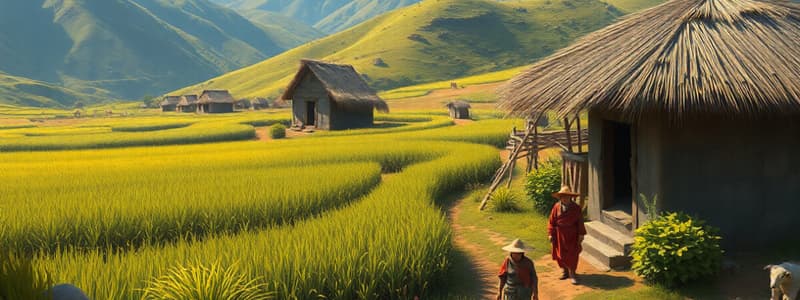Podcast
Questions and Answers
What does the concept of 'verticality' in the Andes refer to?
What does the concept of 'verticality' in the Andes refer to?
- Exploiting multiple ecological tiers at different elevations (correct)
- Urban sprawl
- Community reliance on external resources
- A market-driven economy
The city center in the Andean community is always bustling with residents.
The city center in the Andean community is always bustling with residents.
False (B)
What is one primary animal relied upon for textiles in the Andean community?
What is one primary animal relied upon for textiles in the Andean community?
Camelids such as llamas and alpacas
In the Andes, women traditionally create ________ for significant events such as weddings and funerals.
In the Andes, women traditionally create ________ for significant events such as weddings and funerals.
Which of the following statements best describes the housing pattern in the Andes?
Which of the following statements best describes the housing pattern in the Andes?
Infant mortality rates in the Andes were low even in the 1970s due to access to modern medicine.
Infant mortality rates in the Andes were low even in the 1970s due to access to modern medicine.
What lifestyle aspect in the Andes continued unchanged up until the pandemic?
What lifestyle aspect in the Andes continued unchanged up until the pandemic?
What is the primary reason the Q'eros Indians raise alpacas and llamas?
What is the primary reason the Q'eros Indians raise alpacas and llamas?
The economic system of the Q'eros Indians is fully dependent on trade with outside markets.
The economic system of the Q'eros Indians is fully dependent on trade with outside markets.
At what elevation do the Q'eros Indians live?
At what elevation do the Q'eros Indians live?
The Q'eros have been living in the Andes for over _________ years.
The Q'eros have been living in the Andes for over _________ years.
Flashcards are hidden until you start studying
Study Notes
The Q'eros People
- The Q'eros Indians of Peru have lived in the Andes for over 3,000 years.
- They live at an elevation of 14,000 feet.
- Their economy is nearly self-sufficient.
- Their agricultural methods, music, and weaving practices have remained unchanged for centuries, dating back to the 16th century.
Q'eros Lifestyle
- The Q'eros community is self-sufficient due to their vertical agricultural system.
- Their community's structure is unique and different from urban centers.
- Their community has a central area where community events take place, but no one resides there.
- Men and women perform different roles in the community.
- Weaving is an integral part of Q'eros life, particularly for women.
- Alpaca wool is used for clothing, weddings, and funerals.
- Children and elders care for livestock, while adults perform various chores.
Infant Mortality
- Infant mortality rates were high in the Q'ero community, even in the 1970s, due to limited access to modern healthcare.
Andean Lifestyle
- Andean lifeways are significantly different from modern Western lifestyles.
- The concept of "verticality," which involves multi-ethnic residency and exploitation of different ecological tiers at various elevations, is unique to the Andes.
- This verticality allows them to be self-sufficient without relying on a market system.
Studying That Suits You
Use AI to generate personalized quizzes and flashcards to suit your learning preferences.




